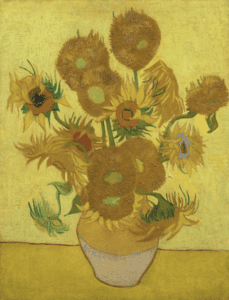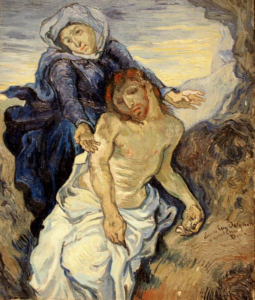Jesus’ Anger
Reflecting on Jesus’ cleansing of the temple in John’s Gospel (2:13–22), Father Richard explores the implications of Jesus’ anger and actions:
Jesus’ actions in the temple are what finally get him killed. After this, religious leaders are dead set against him. Whenever law and order are based on interpretations of divine proclamation, what invariably happens is that the church and state, or religion and government, start working together and operating as one. It’s still true in many countries to this day. Government leaders like to have religion on their side so they can feel like everything they’re doing is blessed by God.
A few years ago, I was at a meeting in Washington, D.C. with nineteen representatives of various denominations. We wrote a statement that listed six different issues where we felt what Jesus teaches and what our government was doing are almost exact opposites. The issues revolved around racism, nationalism, classism that always favors the rich and the powerful, the terrible lack of truth in government, and our constant idealizing of money, war, and power. On every issue, the teaching of Jesus is in direct contradiction to the way our government has often operated.
Yet, if I’m honest, in many ways it’s always been that way; this is nothing new. It’s what’s playing out in this prophetic gospel reading (and in Matthew 21:12–17 also). The temple has become totally aligned with King Herod, with the collecting of taxes and money, and the selling of forgiveness.
Whenever religion gets into the business of the “buying and selling” of God, or of requiring sacrifices to earn God’s love, we have a problem. When Jesus said, “Get these birds out of here,” it’s a clue to the source of Jesus’ anger. The ordinary people had to sacrifice to be right with the priesthood and the temple. They sacrificed oxen and sheep, but the very poor were allowed to offer doves. Mary and Joseph had to give doves when they brought the infant Jesus to the temple (Luke 2:22–24). Jesus knows that his religion is not taking care of the poor; in fact, it’s stealing from the poor, and making them give even the little they have to feel they are right with God.
Jesus is angry about this, and many use this passage to justify violence because Jesus appears pretty violent here. But note that he’s violent toward things, not toward people. He’s liberating animals and trying to liberate the poor from their oppression. Of course, the religious leaders want to protect the building, the temple, but Jesus is redefining the temple. He identifies his body as the temple (John 2:21). The new temple is the human person; we are the body of Christ.
We see Jesus making this great revolution, transforming religion from a concern for sacrifice to earn God’s love to trust through which we know God’s love. And where does that trust happen? In the human heart.
Good and Necessary Anger
Dr. Barbara Holmes describes her felt experience of anger:
Anger is intense. Often, there is a flash of heat and disorientation and the need to justify or retaliate. When I was a child, anger was my response to hurt feelings. When offended, I would lash out or run crying to my mom. In her arms, and with her reassurances, I could quell a heat of rage so intense that it threatened to overtake me. Anger is an emotion that consumes mind and body—but sometimes anger is necessary for survival. [1]
Richard explains how anger helps develop healthy individuals and communities:
Anger is good and very necessary to protect appropriate boundaries of self and others. In men’s work, we call it the “good warrior” archetype. On the other hand, anger becomes self-defeating and egocentric when it hangs around too long after we have received its message. But conscious, visible, felt anger is a gift to consciousness and to community. We need it to know who we are and what boundaries must be defended, along with the depth of hurt and alienation in ourselves and in others with which we are dealing. [2]
Holmes continues:
Many spiritual traditions warn us against anger. We are told that anger provides fertile ground for seeds of discontent, anxiety, and potential harm to self and others. This is true. However, when systems of injustice inflict generational abuses upon people and communities because of their ethnicity, race, sexuality, and/or gender, anger as righteous indignation is appropriate, healthy, and necessary for survival.
Jesus expressed righteous indignation when he encountered the unjust systems of religious and Roman authorities, yet Christian theologies shy away from the integration of anger into their canons. How can churches continue to ignore anger and still be relevant during this era when everyone is angry about everything? People of color are angry about police brutality, white supremacy, white privilege, and economic marginalization.…
A theology of anger [for communities under siege] assumes that anger as a response to injustice is spiritually healthy…. A theology of anger can help us to construct healthy boundaries … [and] the healthy expression of righteous anger can translate communal despair into compassionate action and justice-seeking.… The question is whether or not we will recognize our wounds and the source of our anger so that we can heal ourselves and others and awaken to our potential to embody the beloved community….
If we take a theology of anger seriously, first we come together, then we grieve together, then we consider where we are and where we are going. If there is opportunity, we engage in deep considerations of cause and effect, and we listen for the whispers of the Holy Spirit.… Our health and wholeness require that we take off our masks of Christian piety and do the difficult work of acknowledging our anger, our vulnerability, and our pain. It is this contemplative work that moves us toward forgiveness, for when we recognize our own human frailty, we can more easily forgive the fragility and failings of others. [3]
===================
| FEB 23, 2024 A Greater Artist Than All Others |
“On the walls of the room where the body lay all his canvases were nailed, forming a sort of halo around him, and rendering his death all the more painful to the artists who were present by the splendor of the genius that radiated from them. On the coffin a simple white linen, masses of flowers, the sunflowers which he loved so much, yellow dahlias, yellow flowers everywhere. It was his favorite color….”  It was fitting that Vincent’s body was covered with yellow flowers—the symbol he so often used in his paintings to represent God’s presence and healing love. Directly above the casket hung a single painting—his Pietà showing the lifeless body of Jesus with Vincent’s own face and red hair awaiting the resurrection. Both the flowers and the painting were an affirmation that Vincent believed not even death could separate him from the love of God in Christ.It’s appropriate to conclude this series on the faith and art of Vincent van Gogh with his own words about Christ: “Christ alone, of all the philosophers, magi, etc.—has affirmed as a principle of certainty, eternal life, the infinity of time, the nothingness of death… He lived serenely, as a greater artist than all other artists, despising marble and clay as well as color, working in living flesh. That is to say, this matchless artist, hardly to be conceived of by the obtuse instrument of our modern, nervous, stupefied brains, made neither statues nor pictures nor books; he loudly proclaimed that he made…living men, immortals.” DAILY SCRIPTURE ROMANS 8:31-39 JOHN 10:1-18 WEEKLY PRAYERFrom Henry Van Dyke (1852 – 1933) O Christ, the brightness of God’s glory and express image of his person, whom death could not conquer, nor the tomb imprison; as you have shared our mortal frailty in the flesh, help us to share your immortal triumph in the spirit. Let no shadow of the grave frighten us and no fear of darkness turn our hearts from you. Reveal yourself to us as the first and the last, the Living One, our immortal Savior and Lord. Amen.The post A Greater Artist Than All Others first appeared on With God Daily. |
